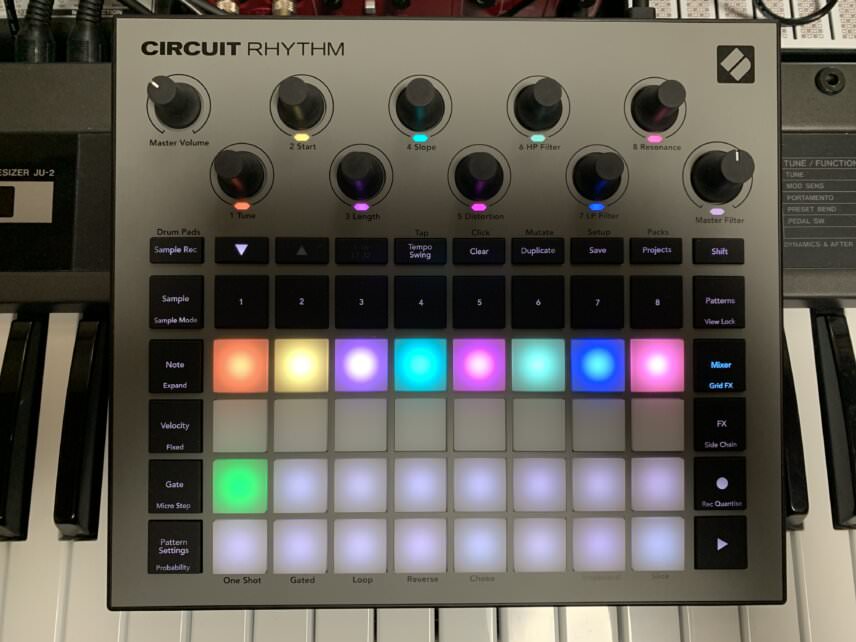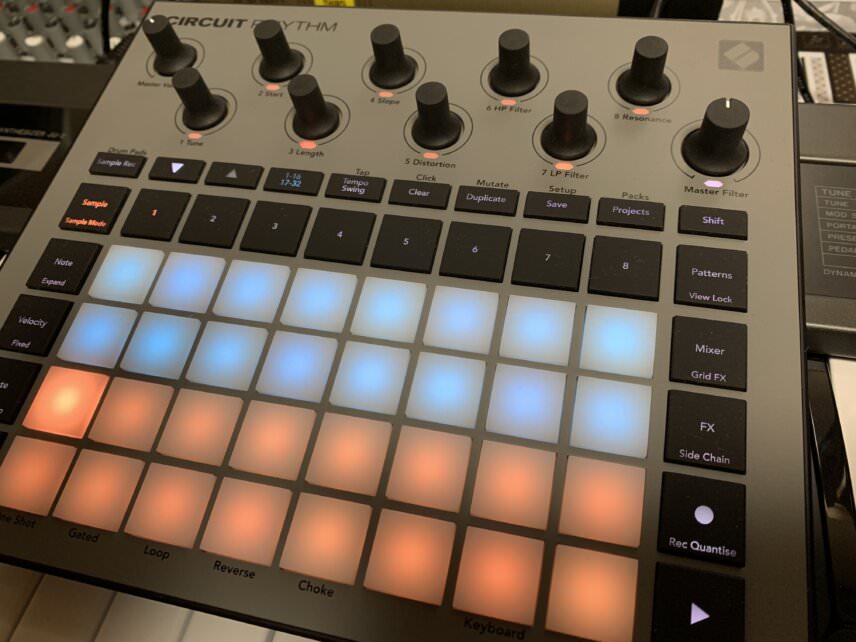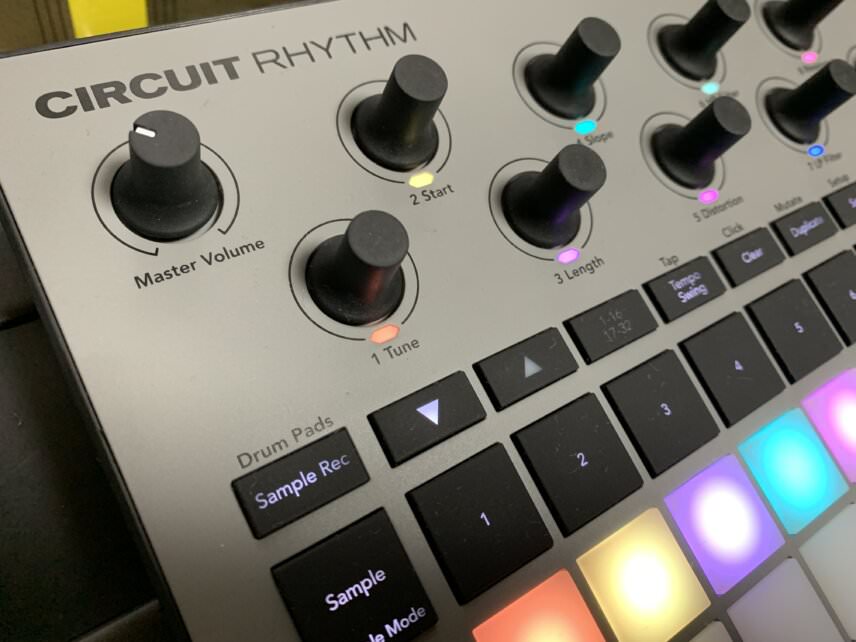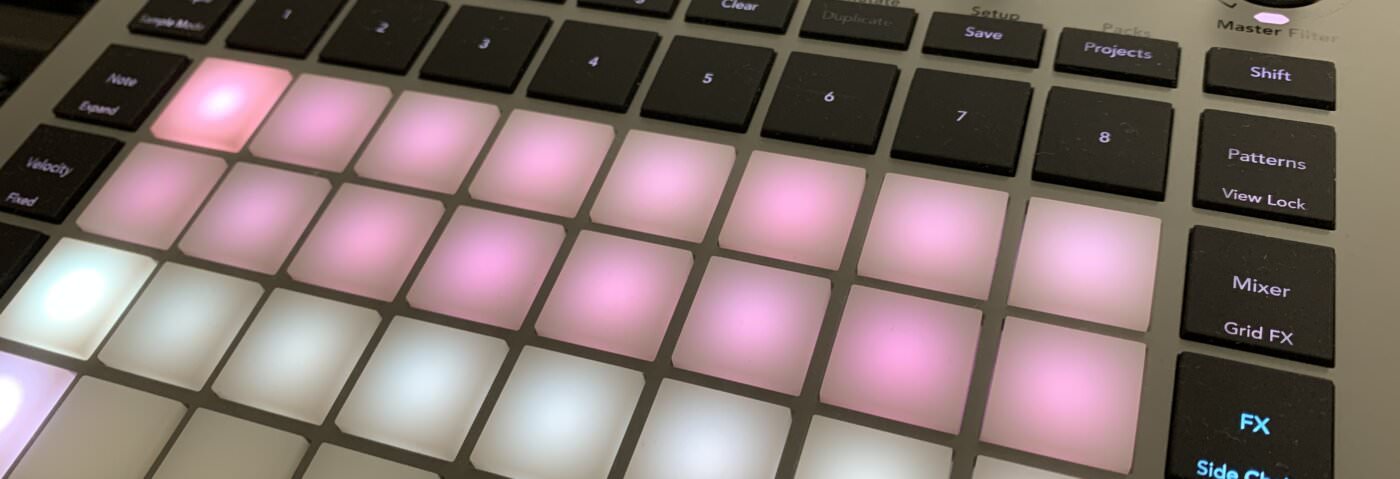Novation adds Rhythm, a sampling drum machine, to its popular Circuit line. Is it the groovebox you’ve been waiting for?
When we first heard that Novation was adding a sampler to its Circuit line of grooveboxes, we were intrigued. Sampling is the foundation of a number of our favourite genres, from hip-hop to jungle, and while old school samplers are fun, they’re not really what you’d call intuitive. Dubbed the Circuit Rhythm, Novation’s entry into the world of sampling seemed like an exciting way to simplify sampling.
Circuit Rhythm is part of the Circuit line of grooveboxes which also includes the latest, Circuit Tracks. Circuit Rhythm shares many similarities with it, including a sequencer, a grid of LCD-lit pads, and a screenless workflow. Where Rhythm differs is in its sound sources: it’s entirely sample-based. This includes a decent factory set of drum sounds, loops and instrument one shots, as well as audio in for sampling your own sounds.
Is this the sampling groovebox you’ve been waiting for? For us, the answer is yes. Mostly.
The Circuit Workflow
Let’s talk about the sequencing first, as this is really where the Circuit Rhythm shines. As mentioned before, the Circuits are screenless machines. At first, this may seem like a deal-breaker but it ingeniously gets around it. The well-made device has ten knobs up top, including Master Volume and macros for things like effects and sample editing. The bottom portion features a grid of 32 pads surrounded by a number of black function buttons. The pads are lit by LCDs and change colour depending on their job. They can also display information usually relegated to a screen, such as tempo BPM and swing percentage, so the lack of a screen isn’t as troubling as we thought it might be.

There are eight tracks for sequencing, each with 16 or 32 steps (chainable up to 256). You can record sequences by step or live, and the latter supports what Novation calls non-quantised record. This is something of a misnomer, as it’s impossible to record completely off the grid. Instead, you can use micro steps that further break each 16-note step into divisions of six. This is great for trills and ratchets but for finger drummers who prefer working without a grid it could lead to some frustration.
Although each track is intended for one sample, you can easily fly in other ones using the sample flip function, so there’s no reason why you couldn’t have two different kicks on the same track, for example. This expands the limited number of tracks, although all sounds on the same track will be treated simultaneously by effects, volume changes, etc. Speaking of, you can capture macro tweaks live or via individual steps. Additional functions like per-step probability and Mutate, which randomizes the notes in a pattern, add to the sequencer’s capabilities.
Building up sequences really is incredibly intuitive and lots of fun and it’s almost reason enough in itself to pick one up.
True Sampling
Unlike some other sample-based grooveboxes on the market, Circuit Rhythm supports not only computer-based sample loading but true sampling. It has stereo line ins (although it samples in mono) and can sample up to 222 seconds per pack (a grouping that includes sequences, samples and Grid Effects – more on these later). This is plenty of time for most productions. The Rhythm can also sample from the internal audio.

Samples are recorded at 48kHz/16-bit so the quality is high. However, there’s no way to reduce the sample rate without using a grid effect and resampling the audio. Considering the popularity of lo-fi genres, this feels like something of a missed opportunity.
There are basic sample editing capabilities as well. Using the macros, you can tune the sample, set start and end points, and add an envelope, although you don’t have control over individual break points in the envelope like attack and decay, just the overall shape. You can also slice a sample into four, eight or 16 slots and edit start and end points of each slice, although without time stretching, you have to adjust the global tempo to fit the loop rather than the other way around.
Adding Effects
As mentioned before the Rhythm has a number of effects, including global and per-track ones. Globally, there’s a lovely DJ-style filter and compressor with sidechain. Delay and reverb presets can be applied to each track and while these won’t blow anyone’s minds, they’re perfectly serviceable. Finally, there are the global Grid FX, which are geared towards performance. They can be momentary or latched and include things like trance gates, phaser, flange, and vinyl emulation, the latter of which was a little harsh to our ears. The Grid FX are loads of fun but we do wish they could be applied to individual tracks.
Limitations We Can Live With
There are a number of limitations inherent in the Circuit Rhythm and this is to be expected. For the price (£280), it already does a lot, and to expect it to compete with something like the Akai MPC One would be silly. However, they still should be mentioned.

First, the Circuit Rhythm is monophonic. Although it has a mode to play in notes chromatically using the pads, you’re restricted to one note at a time. This means it’s impossible to play chords. While it is intended to be a drum machine more than an all-in-one production box, this is still something of a downer.
Second, it only has stereo outs. This means that you can’t record tracks individually without a workaround like muting tracks. Although it has USB, this is only for power and MIDI.
Finally, loading from the SD card can be a little slow, as well as to and from Components, the file manager software. (Note that we also had trouble using Circuit Rhythm with the Chrome version of Components but this could be because ours was a pre-release model.)
Final Thoughts
The Novation Circuit Rhythm is a fun and intuitive groovebox that gets so much right. Sequencing is a breeze, sampling is easy and quick, and the whole experience is a delight. It’s got an internal battery with a four-hour life, is sturdy and well made and would be perfect for taking on the road and busting out some beats. And the lack of a screen becomes a non-issue once you get used to the workflow.
It’s not perfect but at the price (£280), a lot of its quirks can be forgiven. It’s certainly more powerful than a Korg Volca Sample (£110) and has onboard sampling, unlike the Elektron Model:Samples (£215). It’s also quite a bit cheaper than an MPC One (£480), probably its nearest competitor. And about those quirks: Novation has a strong track record of addressing user desires through firmware updates.
If you’ve been wanting to add a sampling drum machine to your already well-equipped studio, this is the one for you. If you’re looking for something more complete, the price will be attractive but the limitations may become frustrating. Ultimately, it’s not an all in one solution but it is a fun way to bring sampling into a drum machine workflow.
The Verdict
Price: £279
Purchase: Novation Circuit Rhythm
The Final Word
Circuit Rhythm brings sampling to the intuitive Circuit workflow.
*Attack Magazine is supported by its audience. When you purchase through links on our site, we may earn an affiliate commission. Learn more.
